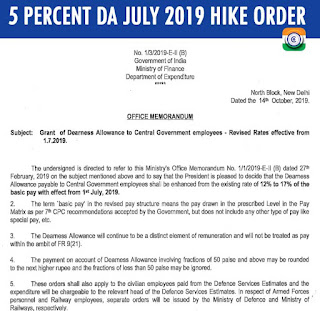House Rent Allowance (HRA) : Report of the Committee on Allowances
House Rent Allowance (HRA) (Para 8.7.3-16)
Existing Provisions: HRA is paid @30, 20 and 10 percent for X class (50 Lakh & above), Y class (5 to 50 lakh) and Z class (below 5 lakh) cities respectively.
At present, in the case of those drawing
either NPA or MSP or both, HRA is being paid as a percentage of BP+NPA
or BP+MSP or BP+NPA+MSP respectively.
Recommendations of 7th CPC:
It has been retained and rationalized. After applying a multiplication
factor of 0.8, the rates have been revised downwards to 24 percent, 16
percent and 8 percent of the Basic Pay for X, Y and Z class cities,
respectively.
The rate of HRA will be revised to 27
percent, 18 percent and 9 percent when DA crosses 50 percent, and
further revised to 30 percent, 20 percent and 10 percent when DA crosses
100 percent. Add-ons like NPA, MSP, etc. should not be included while
working out HRA.
Demands:
I. National Council (Staff Side), JCM: HRA may be
retained @30%, 20% and 10% for X, Y and Z cities respectively as the
Commission has taken unreliable statistics to determine HRA, which has
been reduced by a multiplication factor of 0.8 to 24%, 16% and 8% for X,
Y and Z cities respectively.
II. CAG, Civil Aviation, M/o Health & FW, M/o HRD - D/o of Higher Education, MEA, Coal, DAE, DRDO, Dep. Of Space, CVC: Retain the allowance at the existing rates.
III. M/o of Law & Justice- D/o Justice: Cities having population of more than 1 crore may be granted HRA @ 30%.
Analysis and Recommendations of the Committee: The Committee has the following observations on the recommendations of the 7th CPC on HRA:
(I) HRA rates have been revised downwards by applying the multiplication
factor of 0.8 applied by the 7th CPC on all percentage- based
allowances. This was done to neutralise the significant increase in the
Basic Pay. All fixed allowances have only been given an inflation
indexed increase by the 7th CPC. While the 7th CPC has not explicitly
stated how the multiplication factor of 0.8 has been arrived at anywhere
in the Report, it may be seen that factoring in the expected Dearness
Allowance of 125% on 01.01. 2016 would have yielded a multiplication
factor of 0.875 which may have been rounded off to 0.8.
(II) On the 7th CPC recommendation that the rate of HRA will be revised to 27%, 18% and 9% when DA crosses 50 percent and further revised to 30%, 20% & 10% when DA crosses 100%, the Committee is of the view that given the inflation rates since January 2016 and the RBI policy on inflation, the DA rates might not go beyond 50% in the next 10 years.
(III) While the rents for residential accommodation have not gone up significantly in the recent past and might also have fallen in some areas, the HRA at the rates recommended by the 7th CPC at the lower levels might not continue to be adequate as per the prevailing market rent.
In view of these observations,
the Committee has deliberated upon the following three options which
separately, or in combination, can be suggested by way of modifications
to the 7th CPC recommendations:
Option (i): Having regard to submissions made before it
stating that towards the later part of the ten year period, HRA
compensation falls considerably short of requirement, the 7th CPC has
recommended that the rate of HRA will be revised to 27 percent, 18
percent and 9 percent when DA crosses 50 percent, and further revised to
30 percent, 20 percent and 10 percent when DA crosses 100 percent.
However, considering the present inflation rate, the rate of increase of
the Dearness Allowance and future inflation projections, it appears
unlikely that DA rates will reach 100 % in the ten year period. Taking
this into consideration, the Committee considered that the timing of the
upward revisions in HRA rates proposed by the 7th CPC may be advanced
as under:

This would have no immediate financial
implication and the 1st revision, as per the current trend of increase
in DA, is expected to occur in July, 2018. Accordingly, additional
annual financial implication in July, 2018 will be approximately Rs.1850
crore. The additional financial implication in the second, third and
fourth revision will also be
approximately Rs.1850 crore per annum.
approximately Rs.1850 crore per annum.
Option (ii): Instead of
advancing the full restoration of HRA rates, the Committee considered
splitting the revisions proposed by 7th CPC as under:

The financial implication would be similar as in Option (i) except that the timing of the revision would undergo a change.
Option (iii): It has
been pointed out that at the recommended rates, HRA at the minimum level
might not be sufficient. The minimum HRA calculated at the entry level
of Level 1for X, Y and Z category cities at the rates recommended by the
7th CPC will be Rs.4320, Rs.2880 and Rs.1440 respectively. The Committee
considered recommending that the HRA at the rates recommended by the 7th
CPC may be subject to a floor which may be fixed at Rs.5400, Rs.3600 and Rs.1800 per month, calculated at 30%, 20% and 10% of the minimum pay for
X, Y and Z category cities respectively. This will benefit employees in
Levels 1, 2 and 3.
The additional financial
implication is estimated to be Rs. 385.00 crore and around 7.70 lakh
employees shall be benefited. After a detailed consideration of the
above options, the Committee recommended that either only option (iii)
or option (iii) in combination with option
(ii) be accepted. A final
decision in this regard may be taken by E-CoS.
Click to view the Report








0 comments:
Post a Comment